Climate data guide content with tag Multiple levels
 AIRS (Atmospheric InfraRed Sounder): Version 6 Level 2
AIRS (Atmospheric InfraRed Sounder): Version 6 Level 2
Years of record
- to
AIRS Version 6 Level 2 data represent a significant improvement over AIRS Version 5 Level 2 products in terms of greater stability, yield, and quality. Several algorithmic improvements have been made by the AIRS Project in conjunction with the AIRS Science Team. Improvements include: (a) Improved soundings of Tropospheric and Sea Surface Temperatures, day and night…
Main variables and Earth System components
Atmosphere Aerosols Air Temperature CO Geopotential Height Ozone: Tropospheric Precipitable water Specific HumidityExperts contributing reviews
- N/A
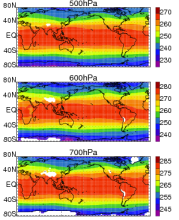 AIRS and AMSU: Tropospheric air temperature and specific humidity
AIRS and AMSU: Tropospheric air temperature and specific humidity
Years of record
- to
The Atmospheric Infrared Sounder (AIRS) project has generated decadal-length, global, gridded data sets of temperature and specific humidity for several standard levels in the troposphere for the obs4MIPS project. This obs4MIPS version of the AIRS data are available at monthly resolution, 1ºx1º grids and formatted to facilitate easier comparisons with CMIP5 model output…
Experts contributing reviews
- Tian, Baijun
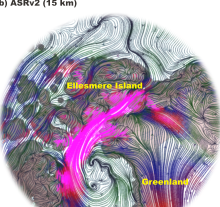 Arctic System Reanalysis (ASR)
Arctic System Reanalysis (ASR)
Years of record
- to
The Arctic System Reanalysis is a multi-agency, university-led retrospective analysis (reanalysis) of the Greater Arctic. ASR is produced using high-resolution versions of the Polar Weather Forecast Model (PWRF) and the WRF-VAR and High Resolution Land Data Assimilation (HRLDAS) data assimilation systems that have been optimized for the Arctic. ASR is a comprehensive…
Experts contributing reviews
- N/A
 Argo Ocean Temperature and Salinity Profiles
Argo Ocean Temperature and Salinity Profiles
Years of record
- to
Argo is an array of over 4100 profiling floats distributed almost uniformly across the global oceans. First deployed in 2000, Argo floats provide temperature and salinity profiles from the surface to a depth of 2000m. The array has approximately 1 float for every 3 degrees of latitude and longitude, providing a new profile once every 10 days. 'Real-time' data…
Main variables and Earth System components
Ocean Salinity Sub Surface Salinity Sub Surface TemperatureExperts contributing reviews
- Scanderbeg, Megan, Purkey, Sarah, Willis, Josh
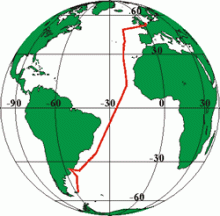 Atlantic Meridional Transect (AMT)
Atlantic Meridional Transect (AMT)
Years of record
- to
"The Atlantic Meridional Transect (AMT) is a multidisciplinary programme which undertakes biological, chemical and physical oceanographic research during an annual voyage between the UK and destinations in the South Atlantic." As of early November, 2013, there have been 23 cruises. AMT data have resulted in many publications including three special issues…
Main variables and Earth System components
N/A-
Formats
- ascii
-
Timestep
- Sub-daily
-
Domain
- Atlantic Ocean
-
Collections
- Carbon cycle
Experts contributing reviews
- N/A
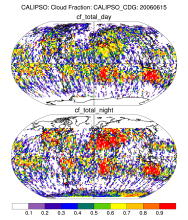 CALIPSO
CALIPSO
Years of record
- to
CALIPSO (Cloud-Aerosol Lidar and Infrared Pathfinder Satellite Observations ) was launched on April 28, 2006 to study the impact of clouds and aerosols on the Earth's radiation budget and climate. It flies in formation with five other satellites in the international "A-Train" constellation for coincident Earth observations. The CALIPSO satellite comprises three…
Experts contributing reviews
- N/A
 CARINA: Carbon in the North Altantic
CARINA: Carbon in the North Altantic
Years of record
- to
The CARINA (CARbon dioxide IN the Atlantic Ocean) data synthesis project is an international collaborative effort of the EU IP CARBOOCEAN, and US partners. It has produced a merged internally consistent data set of open ocean subsurface measurements for biogeochemical investigations, in particular, studies involving the carbon system. The original focus area was the…
-
Formats
- ascii
-
Timestep
- Sub-daily
-
Domain
- Arctic, Atlantic Ocean, Southern Ocean
-
Collections
- Carbon cycle
Experts contributing reviews
- N/A
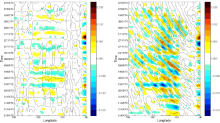 CERA-20C: ECMWF's Coupled Ocean-Atmosphere Reanalysis of the 20th Century
CERA-20C: ECMWF's Coupled Ocean-Atmosphere Reanalysis of the 20th Century
Years of record
- to
The CERA-20C is a global, coupled reanalysis spanning 1901-2010 with a focus on low-frequency climate variability. Similar to ERA-20C, the surface observations assimilated include surface pressures from the International Surface Pressure Databank v3.2.6 and ICOADS v 2.5.1, and surface winds over the oceans from ICOADSv2.5.1. Upper-air and satellite data are…
Main variables and Earth System components
Atmosphere Multiple variables Cryosphere Sea Ice Concentration OceanExperts contributing reviews
- Laloyaux, Patrick
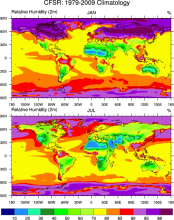 Climate Forecast System Reanalysis (CFSR)
Climate Forecast System Reanalysis (CFSR)
Years of record
- to
The CFSR is a third generation reanalysis product. It is a global, high resolution, coupled atmosphere-ocean-land surface-sea ice system designed to provide the best estimate of the state of these coupled domains over this period. The CFSR includes (1) coupling of atmosphere and ocean during the generation of the 6 hour guess field, (2) an interactive sea-ice model, and…
Main variables and Earth System components
Atmosphere Air Temperature Geopotential Height Precipitable water Ocean-
Formats
- GRIB
-
Timestep
- Sub-daily, Monthly
-
Domain
- Global
-
Collections
- Climate Analysis Section (CAS) Data Catalog
Experts contributing reviews
- N/A
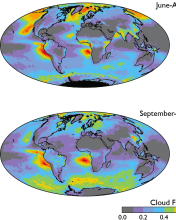 Cloud observations from MODIS
Cloud observations from MODIS
Years of record
- to
The Moderate Resolution Imaging Spectroradiometer (MODIS) is scanning instrument that makes measurements in 36 spectral bands from the visible to the thermal infrared at spatial resolutions from 250 m to 1 km. There are MODIS instruments aboard two sun-synchronous polar-orbiting NASA satellites: Terra, which has a daytime equatorial crossing at about 10:30 am local time…
-
Timestep
- Daily, Monthly, Weekly
-
Domain
- Global
-
Collections
- Diagnostic Data Sets, NCAR-DOE-CESM, atmosdiagnostics, Obs4MIPS
Experts contributing reviews
- Pincus, Robert
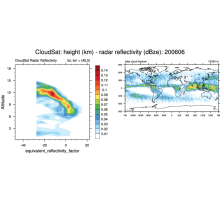 CloudSat
CloudSat
Years of record
- to
CloudSat is a satellite mission designed to measure the vertical structure of clouds from space. The radar data produces detailed images of cloud structures. CloudSat is one of a constellation of satellites known as the A-Train (Cloudsat, CALIPSO, PARASOL, Aqua, Aura, GCOM-W1). The satellites fly in a nearly circular orbit with an equatorial altitude of approximately…
Experts contributing reviews
- N/A
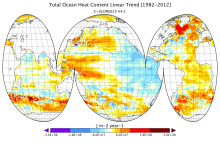 CMCC Global Ocean Reanalysis System (C-GLORS)
CMCC Global Ocean Reanalysis System (C-GLORS)
Years of record
- to
"The CMCC Global Ocean Physical Reanalysis System (C-GLORS) is used to simulate the state of the ocean in the last decades. It consists of a variational data assimilation system (OceanVar), capable of assimilating all in-situ observations along with altimetry data, and a forecast step performed by the ocean model NEMO coupled with the LIM2 sea-ice model…
Main variables and Earth System components
Ocean Ocean Heat Content SST - sea surface temperature Salinity Sub Surface Salinity Sub Surface Temperature mixed layer depth sea surface height u, v current componentsExperts contributing reviews
- Storto, Andrea
 Combined CloudSat spaceborne radar and CALIPSO spaceborne lidar cloud fraction dataset (3S-GEOPROF-COMB)
Combined CloudSat spaceborne radar and CALIPSO spaceborne lidar cloud fraction dataset (3S-GEOPROF-COMB)
Years of record
- to
A global (82S-82N) cloud fraction data set, providing a unique view of cloud vertical structure, has been developed based on the complimentary spaceborne remote sensing capabilities of the CloudSat radar and the CALISPSO lidar. The data set provides monthly mean cloud fraction over several vertical layers for 2006-2019.
-
Formats
- netCDF
-
Timestep
- Monthly, Seasonal, Annual
-
Domain
- Global
-
Collections
- Diagnostic Data Sets, NCAR-DOE-CESM, atmosdiagnostics
Experts contributing reviews
- Bertrand, Leah, Kay, Jennifer
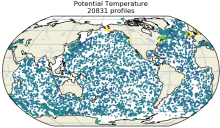 EN4 subsurface temperature and salinity for the global oceans
EN4 subsurface temperature and salinity for the global oceans
Years of record
- to
EN4 is a subsurface temperature and salinity dataset for the global oceans, spanning 1900 to present at a monthly timestep. It includes two types of data products: (1) a database of quality-controled in situ profiles and (2) a spatially complete analyses at 1 by 1 degree horizontal resolution and 42 depth levels for 83S to 90N. Input data include Argo (Argo, 2000), ASBO…
Main variables and Earth System components
Ocean potential temperature Sub Surface Salinity Sub Surface Temperature Sub-surface dataExperts contributing reviews
- Killick, Rachel
 ERA-20C: ECMWF's atmospheric reanalysis of the 20th century (and comparisons with NOAA's 20CR)
ERA-20C: ECMWF's atmospheric reanalysis of the 20th century (and comparisons with NOAA's 20CR)
Years of record
- to
The ECMWF's first atmospheric reanalysis of the 20th Century, ERA-20C, provides a long, gridded dataset of many climate variables, spanning 1900-2010. Observations assimilated include surface pressures from the International Surface Pressure Databank v3.2.6 and ICOADS v 2.5.1, and surface winds over the oceans from ICOADSv2.5.1. Upper-air and satellite data…
-
Timestep
- Sub-daily, Daily, Monthly
-
Domain
- Global
Experts contributing reviews
- Poli, Paul
 ERA5 atmospheric reanalysis
ERA5 atmospheric reanalysis
Years of record
- to
ERA5, the successor to ERA-Interim, provides global, hourly estimates of atmospheric, ocean-wave and land-surface variables, at a horizontal resolution of 31 km and 137 levels in the vertical from the surface to 0.01 hPa (about 80km). Produced by ECMWF on behalf of the European Union’s Copernicus Climate Change Service (C3S), ERA5 extends from 1940 onwards. Each day one…
-
Timestep
- Sub-daily, Daily, Monthly
-
Domain
- Global
-
Collections
- Diagnostic Data Sets
Experts contributing reviews
- Hersbach, Hans
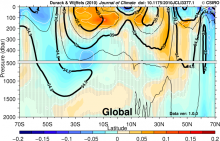 Global Ocean Salinity Change, 1950-2008 (Durack-Wijffels)
Global Ocean Salinity Change, 1950-2008 (Durack-Wijffels)
Years of record
- to
Using data from the Indian Ocean Hydrobase (IOHB) (Kobayashi et al., 2006), Hydrobase2 (Curry, 2002), and Southern Ocean Atlas (Orsi and Whitworth, 2010) databases along with the improved spatial and temporal coverage provided by ARGO profiling data, new estimates of ocean salinity and temperature change (0-2000m) for the period 1950-2008 are derived. The data have been…
Main variables and Earth System components
N/AExperts contributing reviews
- N/A
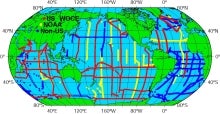 GLODAP: GLobal Ocean Data Analysis Project for Carbon
GLODAP: GLobal Ocean Data Analysis Project for Carbon
Years of record
- N/A
The GLobal Ocean Data Analysis Project (GLODAP) is a cooperative effort to coordinate global synthesis projects funded through the National Oceanic and Atmospheric Administration (NOAA), the U.S. Department of Energy (DOE), and the National Science Foundation (NSF) as part of the Joint Global Ocean Flux Study - Synthesis and Modeling Project (JGOFS-SMP). Cruises…
-
Timestep
- Climatology
-
Domain
- Global
-
Collections
- Carbon cycle
Experts contributing reviews
- N/A
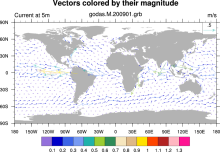 GODAS: NCEP Global Ocean Data Assimilation System
GODAS: NCEP Global Ocean Data Assimilation System
Years of record
- to
GODAS is a real-time ocean analysis and a reanalysis. It is used for monitoring, retrospective analysis as well as for providing oceanic initial conditions for the CFS. Both temperature and synthetic salinity profiles are assimilated in a 3DVAR scheme. Beginning with March 2007, altimetry sea level is assimilated.
Main variables and Earth System components
Ocean 3D Velocity SST - sea surface temperature Salinity heat flux isothermal layer depth mixed layer depth potential temperature salt flux sea surface height-
Timestep
- Monthly, Pentad
-
Domain
- Global
-
Collections
- Climate Analysis Section (CAS) Data Catalog
Experts contributing reviews
- N/A
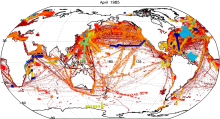 HadIOD: Met Office-Hadley Centre Integrated Ocean Database
HadIOD: Met Office-Hadley Centre Integrated Ocean Database
Years of record
- to
HadIOD (Met Office Hadley Centre Integrated Ocean Database) is a global database of in situ ocean temperature and salinity observations, spanning 1850-present on a daily timestep. It is somewhat unique among temperature and salinity datasets in that it combines observations from both surface and sub-surface observing platforms. As such, it is well suited to activities…
Main variables and Earth System components
Ocean Salinity SST - sea surface temperature Sub Surface TemperatureExperts contributing reviews
- Atkinson, Chris
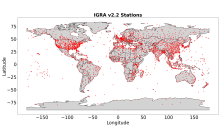 Integrated Global Radiosonde Archive (IGRA)
Integrated Global Radiosonde Archive (IGRA)
Years of record
- to
The largest publicly available collection of quality-controlled, globally-distributed, historical radiosonde and pilot balloon observations is the Integrated Global Radiosonde Archive (IGRA; Durre et al. 2006, 2018). First released in 2004, IGRA is maintained and distributed by NOAA’s National Centers for Environmental Information (NCEI). IGRA v2.2, which was released…
Main variables and Earth System components
Atmosphere Dew Point Temperature Geopotential Height Multiple variables Relative Humidity WindExperts contributing reviews
- Durre, Imke, Korzeniewski, Bryant
 JRA-55
JRA-55
Years of record
- to
Spanning 1958-present, JRA-55 is the longest third-generation reanalysis that uses the full observing system (in contrast, products like ERA-20C and NOAA 20CR assimilate a very limited set of observations while NCEP R1 uses an antiquated model and assimilation scheme). Compared to the previous generation Japanese Meteorological Agency (JMA) reanalysis, JRA-25, JRA…
Main variables and Earth System components
Atmosphere Air Temperature Geopotential Height Precipitable waterExperts contributing reviews
- Kobayashi, Shinya
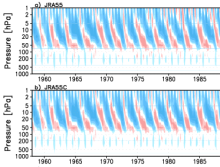 JRA-55C (reanalysis using conventional observations)
JRA-55C (reanalysis using conventional observations)
Years of record
- to
JRA-55C is a fixed observing system atmospheric reanalysis that uses the same model and data assimilation scheme as JRA-55. The observations assimilated include surface station data, radiosondes, tropical cyclone retrievals and wind profilers. No satellite observations are included. JRA-55C spans November, 1972 thru December, 2012 but may be extended back to…
Main variables and Earth System components
N/AExperts contributing reviews
- Kobayashi, Chiaki
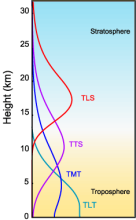 MSU/AMSU Atmospheric Temperature Climate Data Record, Remote Sensing Systems (RSS)
MSU/AMSU Atmospheric Temperature Climate Data Record, Remote Sensing Systems (RSS)
Years of record
- to
A long (30-year+) data set of atmospheric temperatures for 4 tropopsheric and lower stratopsheric layers has been derived from brightness temperatures measured by the Microwave Sounding Unit (MSU) and Advanced Microwave Sounding Unit (AMSU). This page describes the data sets developed by Remote Sensing Systems (RSS); other options exist for comparisons. One of the most…
-
Timestep
- Monthly
-
Domain
- Global
-
Collections
- Climate Data Record
Experts contributing reviews
- Mears, Carl
 NASA's MERRA2 reanalysis
NASA's MERRA2 reanalysis
Years of record
- to
The Modern-Era Retrospective analysis for Research and Applications, version 2 (MERRA-2) is a global atmospheric reanalysis produced by the NASA Global Modeling and Assimilation Office (GMAO). It spans the satellite observing era from 1980 to the present. The goals of MERRA-2 are to provide a regularly-gridded, homogeneous record of the global atmosphere, and to…
Main variables and Earth System components
Atmosphere Aerosols Air Temperature Geopotential Height Precipitable waterExperts contributing reviews
- Bosilovich, Michael, Cullather, Richard
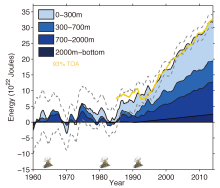 Ocean temperature analysis and heat content estimate from Institute of Atmospheric Physics
Ocean temperature analysis and heat content estimate from Institute of Atmospheric Physics
Years of record
- to
The Institute of Atmospheric Physics (IAP) ocean temperature analysis features global coverage of the oceans, at 1° x1° horizontal resolution on 41 vertical levels from 1-2000m, and monthly resolution from 1940 to present. As such, it is aimed at studies of climate variability and change, from large regional to global scales, on timescales of months to decades.…
Main variables and Earth System components
Ocean Ocean Heat Content Sea Level Sub Surface TemperatureExperts contributing reviews
- Cheng, Lijing
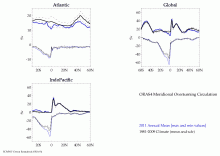 ORAS4: ECMWF Ocean Reanalysis and derived ocean heat content
ORAS4: ECMWF Ocean Reanalysis and derived ocean heat content
Years of record
- to
ECMWF's current ocean reanalysis uses a sophisticated data assimilation methodology which includes a model bias correction. The ocean model used is forced by atmospheric daily surface fluxes, relaxed to SST and bias corrected. The Balmaseda et al (QJRMS 2013) reference provides excellent peer reviewed documentation and evaluation.
Main variables and Earth System components
Ocean Ocean Heat Content Salinity Sea Level potential temperature u, v current components-
Timestep
- Monthly
-
Domain
- Global
-
Collections
- Climate Analysis Section (CAS) Data Catalog
Experts contributing reviews
- N/A
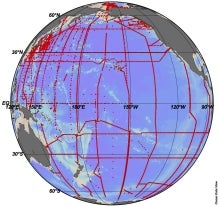 PACIFICA: PACIFic ocean Interior CArbon
PACIFICA: PACIFic ocean Interior CArbon
Years of record
- to
PACIFICA (PACIFic ocean Interior CArbon) was an international collaborative project for the data synthesis of ocean interior carbon and its related parameters in the Pacific Ocean. The North Pacific Marine Science Organization (PICES), Section of Carbon and Climate (S-CC) supported the project. We have merged hydrographic/hydrochemical datasets from a total of 213…
-
Formats
- ascii
-
Timestep
- Sub-daily
-
Domain
- Pacific Ocean
-
Collections
- Carbon cycle
Experts contributing reviews
- N/A
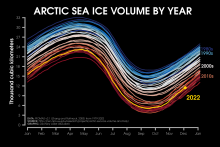 Pan-Arctic Ice Ocean Modeling and Assimilation System (PIOMAS)
Pan-Arctic Ice Ocean Modeling and Assimilation System (PIOMAS)
Years of record
- to
The Pan-Arctic Ice-Ocean Modeling and Assimilation System (PIOMAS) is a reanalysis data set that uses a coupled ice and ocean model to provide daily and monthly estimates of Arctic sea-ice thickness. The data is publicly available from January 1979 to in near-real time. The model is developed and maintained by the Polar Science Center (PSC) in the Applied Physics…
Experts contributing reviews
- Labe, Zachary
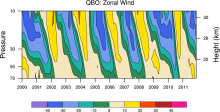 QBO: Quasi-Biennial Oscillation
QBO: Quasi-Biennial Oscillation
Years of record
- to
The quasi-biennial oscillation (QBO) is a quasi-periodic oscillation of the equatorial zonal wind between easterlies and westerlies in the tropical stratosphere with a mean period of 28 to 29 months. The alternating wind regimes develop at the top of the lower stratosphere and propagate downwards at about 1 km (0.6 mi) per month until they are dissipated at the tropical…
Experts contributing reviews
- N/A
 Radiative kernels from climate models
Radiative kernels from climate models
Years of record
- N/A
The radiative kernel technique is a method used to quantify radiative feedbacks in response to global warming. Radiative kernels are commonly calculated for the water vapor, lapse rate, temperature and albedo feedbacks. Radiative kernels are used to deconstruct the various contributions of feedbacks and forcings to the total change in top-of-atmosphere (TOA…
Main variables and Earth System components
N/AExperts contributing reviews
- Pendergrass, Angeline
 RAPID: monitoring the Atlantic Meridional Overturning Circulation at 26.5°N
RAPID: monitoring the Atlantic Meridional Overturning Circulation at 26.5°N
Years of record
- to
"The Rapid Climate Change programme (RAPID) explores what causes rapid switches in climate, with a main (but not exclusive) focus on the Atlantic Ocean's thermohaline circulation." "A principal objective of the RAPID programme is the development and maintenance of a pre-operational prototype system that will continuously observe the strength and structure of the MOC. An…
Main variables and Earth System components
Ocean Salinity Sub Surface Temperature heat flux streamfunction-
Timestep
- Sub-daily
-
Domain
- Atlantic Ocean
-
Collections
- Diagnostic Data Sets
Experts contributing reviews
- N/A
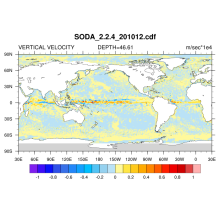 SODA: Simple Ocean Data Assimilation
SODA: Simple Ocean Data Assimilation
Years of record
- to
The Simple Ocean Data Assimilation, or SODA, analysis is an ocean reanalysis data set consisting of gridded variables for the global ocean, as well as several derived fields. The goal is to provide an improved estimate of ocean state from those based solely on observations or numerical simulations.
Main variables and Earth System components
Wind Stress Ocean 3D Velocity potential temperature Salinity sea surface height SST - sea surface temperature u, v current componentsExperts contributing reviews
- N/A
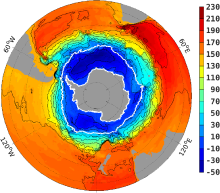 Southern Ocean State Estimate (SOSE)
Southern Ocean State Estimate (SOSE)
Years of record
- to
The Southern Ocean State Estimate (SOSE) is a model-generated best fit to Southern Ocean observations. As such, it provides a quantitatively useful climatology of the mean-state of the Southern Ocean. Technically, SOSE is a solution to the MITgcm. SOSE is a gridded dataset at 1/6 ° horizontal resolution, available at timesteps from daily to annually.…
Main variables and Earth System components
Ocean 3D Velocity Bottom pressure SST - sea surface temperature Salinity Sub Surface Temperature mixed layer depth sea surface height u, v current components Wind Stress-
Formats
- binary
-
Timestep
- Daily, Monthly, Weekly, Annual
-
Collections
- N/A
Experts contributing reviews
- Mazloff, Matthew
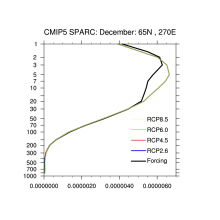 Stratospheric & Tropospheric Ozone: ACC/SPARC (Atmospheric Chemistry and Climate / Stratospheric Processes and their Role in Climate)
Stratospheric & Tropospheric Ozone: ACC/SPARC (Atmospheric Chemistry and Climate / Stratospheric Processes and their Role in Climate)
Years of record
- to
"The AC&C/SPARC ozone database covers the period 1850 to 2100 and can be used as forcing in climate models that do not include interactive chemistry. The historical part of the AC&C/SPARC ozone database spans the period 1850 to 2009 and consists of separate stratospheric and tropospheric data sources: (1) A multiple linear regression analysis of SAGE I+II…
-
Formats
- netCDF
-
Timestep
- Monthly
-
Domain
- Global
-
Collections
- Boundary Conditions, CMIP5-recommended, AC&C/SPARC ozone
Experts contributing reviews
- N/A
 Stratospheric Ozone: Randel & Wu 2007
Stratospheric Ozone: Randel & Wu 2007
Years of record
- to
This is a monthly, zonal-mean ozone profile data set spanning 1979–2005 for altitudes from the tropopause up to 50 km. Interannual variability is based on a combination of SAGE (Stratospheric Aerosol and Gas Experiment) satellite profile measurements and polar ozonesondes. The interannual anomalies were added to a climatology from Fortuin and Kelder (1998). …
-
Formats
- binary
-
Timestep
- Monthly
-
Domain
- Global
-
Collections
- Boundary Conditions
Experts contributing reviews
- Randel, Bill
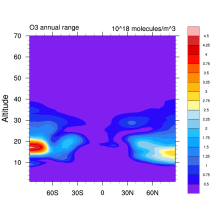 Stratospheric Ozone: Vertically Resolved, zonal mean based on BDBP
Stratospheric Ozone: Vertically Resolved, zonal mean based on BDBP
Years of record
- to
Combined monthly mean vertical ozone profile database spanning the period 1979 to 2007. The database is completely filled such that there are no missing data. The raw individual ozone data are sourced from the BDBP database. Monthly means are calculated from individual ozone measurements extracted from the BDBP in much the same way as in Hassler et al. (2009).…
Experts contributing reviews
- Hassler, Birgit
 Tropical Moored Buoy System: TAO, TRITON, PIRATA, RAMA (TOGA)
Tropical Moored Buoy System: TAO, TRITON, PIRATA, RAMA (TOGA)
Years of record
- to
The Tropical Ocean Global Atmosphere program (TOGA) is a component of the World Climate Research Programme (WCRP) aimed specifically at the prediction of climate phenomena on time scales of months to years. In order to achieve the TOGA goals, a strategy of large-scale, long-term monitoring of the upper ocean and the atmosphere has been developed. In particular, several…
Main variables and Earth System components
Atmosphere Air Temperature Precipitation Radiation Relative Humidity Sea Level Pressure Wind Ocean Absolute Dynamic Topography (ADT) Ocean Heat Content SST - sea surface temperature Salinity Sub Surface Salinity Sub Surface Temperature u, v current componentsExperts contributing reviews
- N/A
 World Ocean Atlas (WOA09)
World Ocean Atlas (WOA09)
Years of record
- N/A
World Ocean Atlas 2009 (WOA09) is a set of objectively analyzed (1 degree grid) climatological fields of in situ temperature, salinity, dissolved oxygen, Apparent Oxygen Utilization (AOU), percent oxygen saturation, phosphate, silicate, and nitrate at standard depth levels for annual, seasonal, and monthly compositing periods for the World Ocean. It also includes…
Main variables and Earth System components
Ocean Dissolved Oxygen SST - sea surface temperature Salinity Sub Surface Salinity Sub Surface Temperature oxygen saturation phosphate silicate-
Timestep
- Climatology, Monthly, Seasonal, Annual
-
Domain
- Global
-
Collections
- Diagnostic Data Sets, NCAR-DOE-CESM, oceandiagnostics
Experts contributing reviews
- N/A
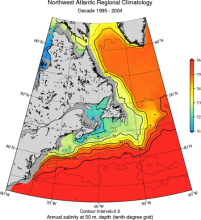 World Ocean Atlas 2013 (WOA13)
World Ocean Atlas 2013 (WOA13)
Years of record
- to
The World Ocean Atlas (WOA) is a set of climatological mean, gridded fields of oceanographic variables based on in-situ measurements from a wide variety of sources. Global, decadal averages of temperature, salinity, oxygen and nutrients are provided at monthly, seasonal and annual averaging periods on 102 standard depth levels from 0 to 5500m, and at 0.25° (…
Main variables and Earth System components
Ocean Dissolved Oxygen phosphate potential temperature silicate SST - sea surface temperature Sub Surface Salinity Sub Surface Temperature Sub-surface data-
Timestep
- Climatology, Monthly, Seasonal
-
Domain
- Global
-
Collections
- Diagnostic Data Sets, NCAR-DOE-CESM, oceandiagnostics
Experts contributing reviews
- Mishonov, Alexey